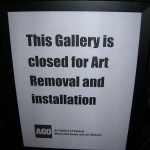An exhibition closes. The doors close behind it. The notice goes up. Weeks and weeks go by.
What are they doing in there?
 A lot, as it happens. And, on average, we still open the next show five to six weeks sooner than comparable art institutions, offering comparable exhibitions. That comparison comes from someone well-placed to offer it: Jessica Bright, Interim Head of Exhibition Development and Senior Project Manager.
A lot, as it happens. And, on average, we still open the next show five to six weeks sooner than comparable art institutions, offering comparable exhibitions. That comparison comes from someone well-placed to offer it: Jessica Bright, Interim Head of Exhibition Development and Senior Project Manager.
The work breaks into three broad stages. First: art removal.
- Couriers (usually conservators) from the lending institution(s) work with the cross-disciplinary team of AGO staff to prepare a condition report on each piece. “We could be hosting up to 25 colleagues,” says Jessica. “Together, we examine and document each work of art, to ensure no change or damage has occured while it is here.”
- The work is next dismantled (which may involve removing layers of security devices, hardware or mounts), then wrapped and packed in its original crate. “We carefully document the unpacking, so we know exactly how to repack each piece to travel safely.” The crates are then sealed.
- A flight is booked for each piece and its courier, and transportation arranged. Sounds simple, can be extremely complex. “If we’re the last venue, we have to return the works to their lenders, which could be 40 locations, all over the world.” Jessica calls this step “as much a ballet of coordination as a logistical jigsaw puzzle.”
Second stage: prepare the Zacks Gallery for the next exhibition. We reconfigure as few walls as possible, but there is still some demolishing and reconstruction, plus painting and, sometimes, carpeting. “We work hard to create an appropriate atmosphere for each show,” says Jessica. “Picasso, for example, was largely clean, stark and bright, whereas Frida & Diego has a warmer palette — earthy tones with punches of bright primary colours.”
Third stage: install the new exhibition. “Stage one in reverse,” says Jessica. The next group of visiting couriers works with our staff, solving the next logistical jigsaw puzzle. Then the final touches: graphics, a thorough cleaning of the entire installation, and previews.
It’s meticulous work, one detail after another, with much at stake. Jessica is in her element.
“I love it, love it, love it! I get to lead a team that creates experiences with art for the public. We handle great treasures, and our work has direct, tangible results.”